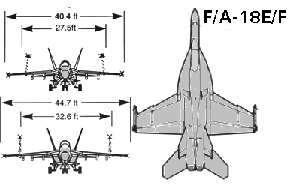| Home Page
Photos
Ribbons
Recruiting
Rank
Intell
NAVY Squadrons
Newswire
Wing Staff
Guest Book Page
|
|
F/A-18 Specs.
Primary Function: Multi-role attack and fighter aircraft
Contractor: McDonnell Douglas
Unit Cost: $ 57 million
Propulsion: Two F414-GE-400 turbofan engines
Thrust: 22,000 pounds (9,977 kg) static thrust per engine
Length: 60.3 feet (18.5 meters)
Height: 16 feet (4.87 meters)
Maximum Take Off Gross Weight: 66,000 pounds (29,932 kg)
Wingspan: 44.9 feet (13.68 meters)
Range:
Combat: 1,275 nautical miles (2,346 kilometers), clean plus two AIM-9s
Ferry: 1,660 nautical miles (3,054 kilometers), two AIM-9s, three 480 gallon tanks retained
Ceiling: 50,000+ feet
Speed: Mach 1.8+
Crew:
A, C and E models: One
B, D and F models: Two
Armament: One M61A1/A2 Vulcan 20mm cannon;
External payload: AIM 9 Sidewinder, AIM-9X (projected), AIM 7 Sparrow, AIM-120 AMRAAM, Harpoon, Harm, SLAM, SLAM-ER (projected), Maverick missiles; Joint Stand-Off Weapon (JSOW); Joint Direct Attack Munition (JDAM); Data Link Pod; Paveway Laser Guided Bomb; various general purpose bombs, mines and rockets. See the F/A-18 weapons load-out page.
Date Deployed: First flight in November 1995. Initial Operational Capability (IOC) in September 2001 with VFA-115, NAS Lemoore, Calif. First cruise for VFA-115 is onboard the USS Abraham Lincoln.
|
|
|
 Specifications
Specifications
Contractor Boeing [McDonnell Douglas Aerospace] and
Northrop Grumman (Airframe),
General Electric (Engines), and
Hughes (Radar)
F/A-18C/D
Hornet F/A-18E/F
Super Hornet
Power Plant Two F404-GE-402 afterburning engines, each in the 18,000 pound thrust class, which results in a combat thrust-to-weight ratio greater than 1-to-1. Depending on the mission and loading, combat radius is greater than 500 nautical miles. Twin F414-GE-400 engines, each in the 22,000 pound thrust class. On an interdiction mission, the E/F will fly up to 40 % further than the C/D.
Accommodations The F/A-18C and F/A-18E are single seat aircraft.
The D and F models are flown by two crew members.
The aft seat in the D and F may be configured with a stick and throttle for the training environment (or without when crewed with a Weapons System Officer).
Performance F/A-18C maximum speed at level flight in altitudes of 36,089 ft.
Mach 1.7
F/A-18E maximum speed at level flight in altitudes of 36,089 ft.
Mach 1.6
Armament F/A-18C/D can carry up to 13,700 pounds of external ordnance.
Weapon stations include: two wingtip stations for Sidewinders; two outboard wing stations for air-to-air or air-to-ground weapons; two inboard wing stations for fuel tanks, air-to-air, or air-to-ground weapons; two nacelle fuselage stations for AMRAAMs, Sparrows, or sensor pods; and one centerline station for fuel or air-to-ground weapons.
M61 Vulcan 6-barrel rotary cannon with 520 rounds of 20mm ammunition is internally mounted in the nose
AIM-9 Sidewinder
AIM-7F Sparrow
AIM-120 AMRAAM
AGM-65E Maverick
AGM-84 Harpoon
AGM-88A HARM
MK82
10 CBU-87
10 CBU-89
GBU-12
GBU-24
JDAM
B-57 or B-61 Nuclear bomb
F/A-18E/F can carry up to 17,750 pounds of external ordnance; two additional wing store stations have been added.
Mission and Capabilities The F/A-18 Hornet can perform both air-to-air and air-to-ground missions.
Cockpit displays and mission avionics are thoroughly integrated to enhance crew situational awareness and mission capability in high threat, adverse weather/night environments.
Cockpits are night vision goggle compatible.
Multi-Sensor Integration and advanced data link capabilities further enhance situational awareness.
The E/F model will be able to perform a strike tanker mission while carrying a self-protection air-to-air missile loadout.
The E/F model will also have greater payload flexibility, increased mission radius, survivability, payload bring back, and a substantial avionics growth potential.
Unit cost
[Total Program] .5 million. million
Program Summary F/A-18A/B first entered operational service with the USN and USMC in 1982.
Since 1982, more than 1,458 F/A-18s have been procured for the USN and USMC and for the armed services in Canada, Australia, Spain, Kuwait, Switzerland, Finland, and Malaysia.
In 1987, the upgraded C/D model (with enhanced mission avionics) was introduced and upgraded with a night/adverse weather mission capability, On Board Oxygen Generating System, APG-73 Radar Upgrade, enhanced performance F404-GE-402 engines, and upgraded mission computers.
The first flight of the F/A-18E/F occurred in December 1995; operational deliveries are scheduled for late 1999.
|
|
|
|
|
|
|
|
|
|
|
|
|


